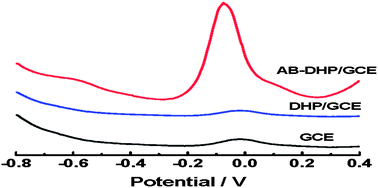Enhanced oxidation and detection of methyl parathion using an acetylene black nanoparticle–dihexadecyl hydrogen phosphate composite film
Abstract
Insoluble acetylene black (AB) nanoparticles were easily dispersed into water in the presence of dihexadecyl hydrogen phosphate (DHP), and then used to modify the glassy carbon electrode (GCE) surface via solvent evaporation. Scanning electron microscopy measurements indicated that the GCE surface was fully coated with AB nanoparticles after modification. Compared with the bare GCE, the AB–DHP film-modified GCE greatly increased the oxidation peak current of methyl parathion (MP), indicative of strong signal enhancement effects. The influences of the pH value, amount of AB–DHP suspension, accumulation potential and time were investigated. As a result, a novel electrochemical method with high sensitivity and rapid response was developed for the detection of MP. The linear range was from 5 × 10−8 to 1 × 10−5 M with a linear coefficient of 0.998, and the detection limit was 8 × 10−9 M. The method was successfully used to detect MP in water samples, and the value of recovery was over the range from 96.8% to 102.2%.


 Please wait while we load your content...
Please wait while we load your content...